Scatter Plot Matrices - R Base Graphs
Previously, we described the essentials of R programming and provided quick start guides for importing data into R.
Pleleminary tasks
Launch RStudio as described here: Running RStudio and setting up your working directory
Prepare your data as described here: Best practices for preparing your data and save it in an external .txt tab or .csv files
Import your data into R as described here: Fast reading of data from txt|csv files into R: readr package.
Here, we’ll use the R built-in iris data set.
Data
iris data is used in the following examples. iris data set gives the measurements in centimeters of the variables sepal length and width, and petal length and width, respectively, for 50 flowers from each of 3 species of iris. The species are Iris setosa, versicolor, and virginica.
head(iris)## Sepal.Length Sepal.Width Petal.Length Petal.Width Species
## 1 5.1 3.5 1.4 0.2 setosa
## 2 4.9 3.0 1.4 0.2 setosa
## 3 4.7 3.2 1.3 0.2 setosa
## 4 4.6 3.1 1.5 0.2 setosa
## 5 5.0 3.6 1.4 0.2 setosa
## 6 5.4 3.9 1.7 0.4 setosaR base scatter plot matrices: pairs()
- Basic plots:
pairs(iris[,1:4], pch = 19)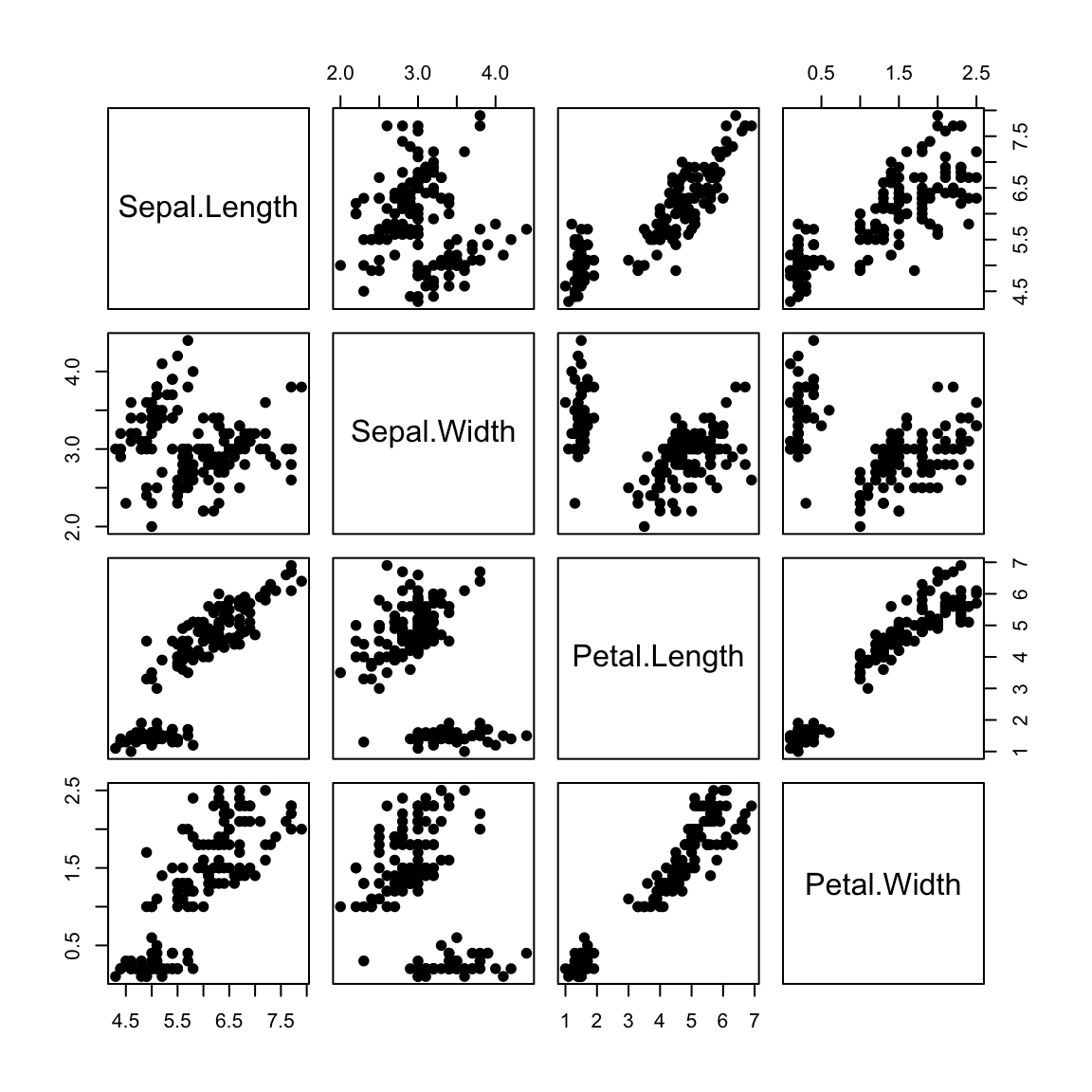
- Show only upper panel:
pairs(iris[,1:4], pch = 19, lower.panel = NULL)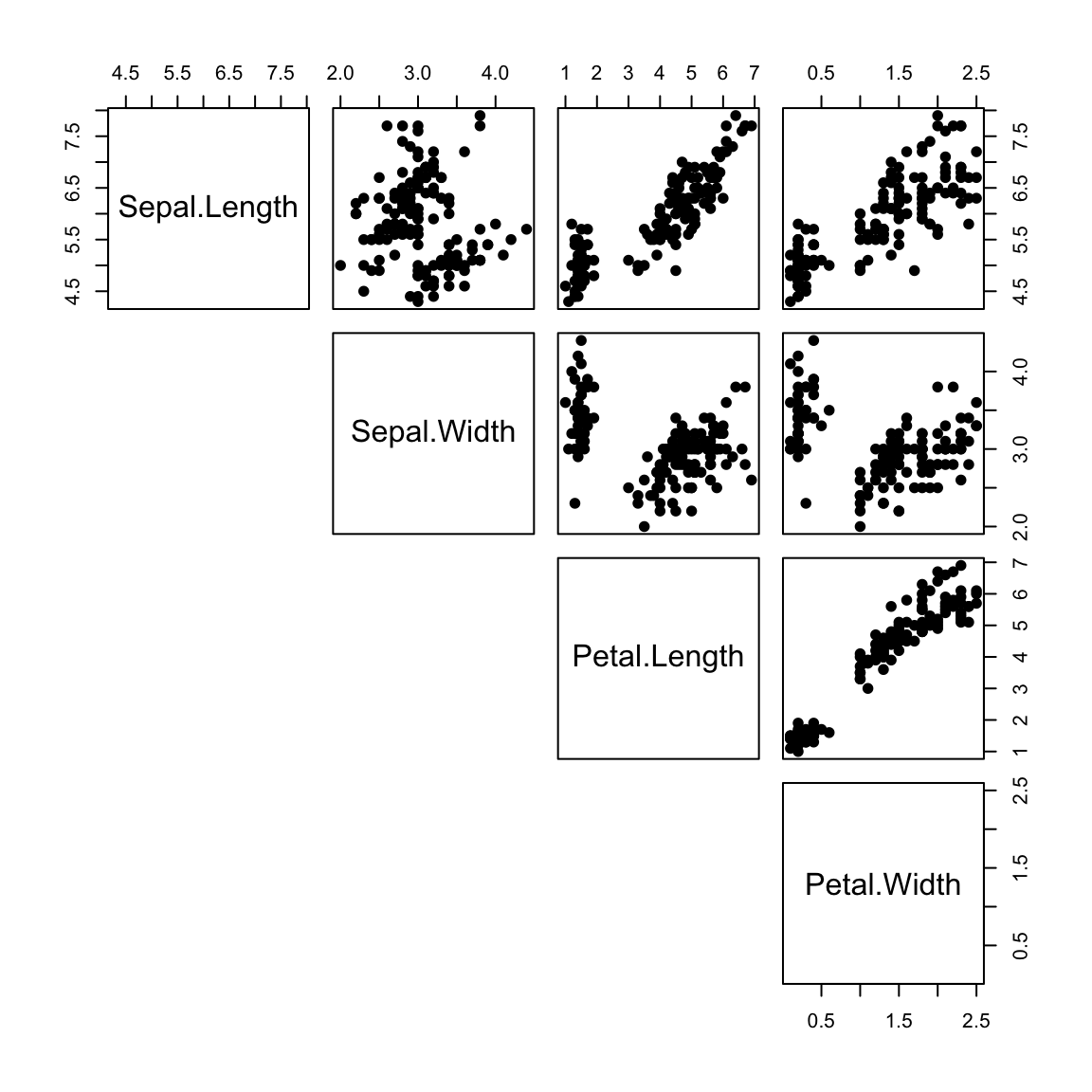
Note that, to keep only lower.panel, use the argument upper.panel=NULL
- Color points by groups (species)
my_cols <- c("#00AFBB", "#E7B800", "#FC4E07")
pairs(iris[,1:4], pch = 19, cex = 0.5,
col = my_cols[iris$Species],
lower.panel=NULL)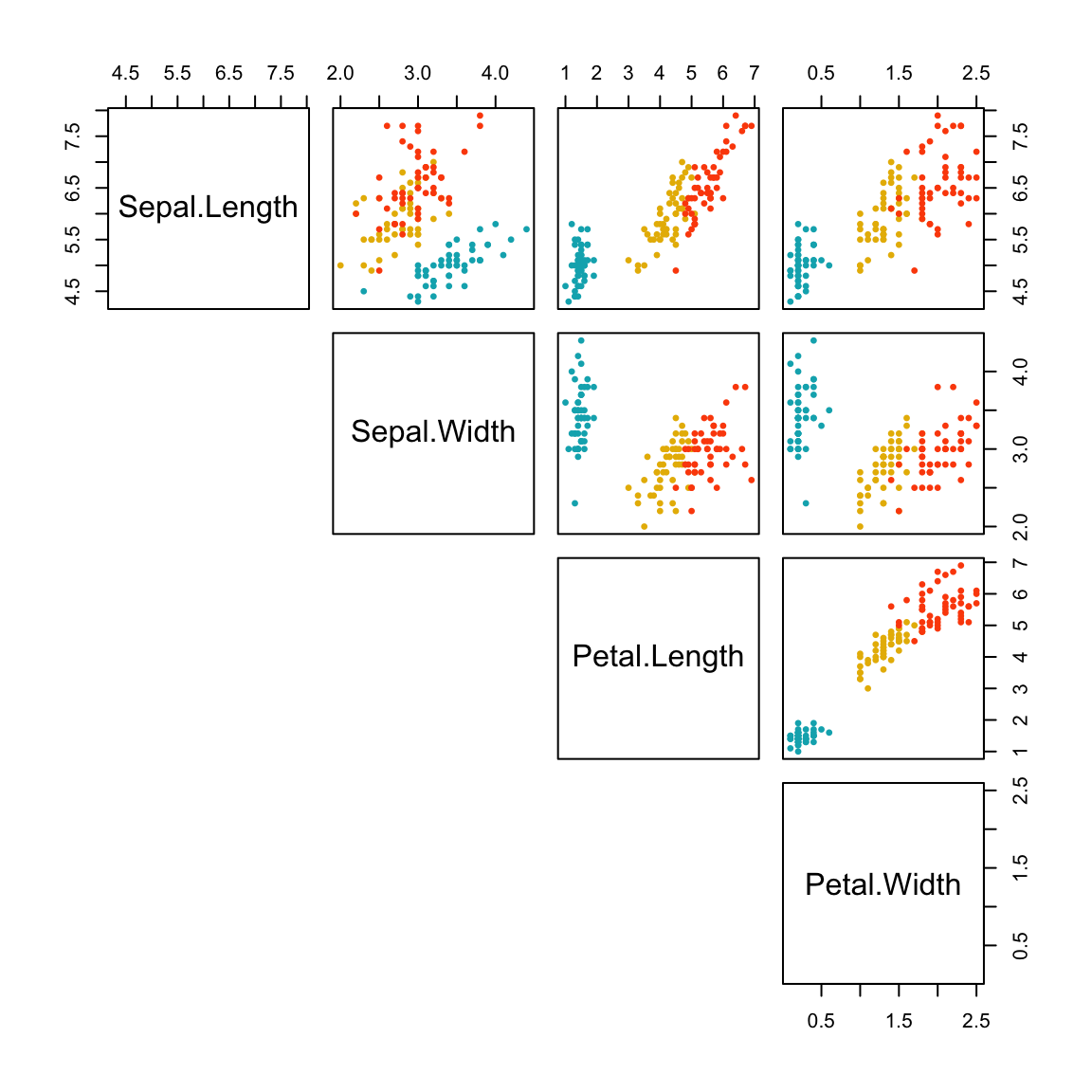
- Add correlations on the lower panels: The size of the text is proportional to the correlations.
# Correlation panel
panel.cor <- function(x, y){
usr <- par("usr"); on.exit(par(usr))
par(usr = c(0, 1, 0, 1))
r <- round(cor(x, y), digits=2)
txt <- paste0("R = ", r)
cex.cor <- 0.8/strwidth(txt)
text(0.5, 0.5, txt, cex = cex.cor * r)
}
# Customize upper panel
upper.panel<-function(x, y){
points(x,y, pch = 19, col = my_cols[iris$Species])
}
# Create the plots
pairs(iris[,1:4],
lower.panel = panel.cor,
upper.panel = upper.panel)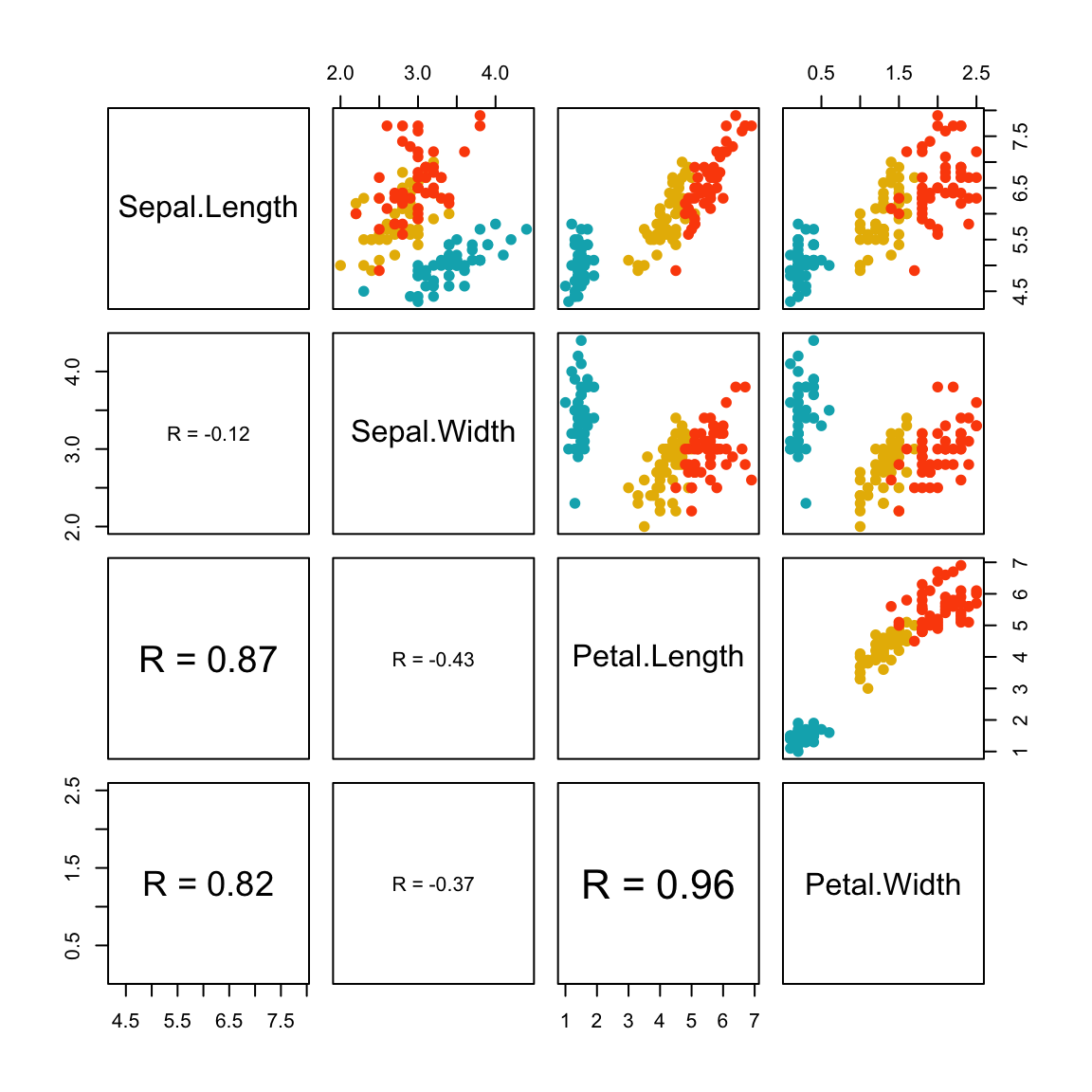
- Add correlations on the scatter plots:
# Customize upper panel
upper.panel<-function(x, y){
points(x,y, pch=19, col=c("red", "green3", "blue")[iris$Species])
r <- round(cor(x, y), digits=2)
txt <- paste0("R = ", r)
usr <- par("usr"); on.exit(par(usr))
par(usr = c(0, 1, 0, 1))
text(0.5, 0.9, txt)
}
pairs(iris[,1:4], lower.panel = NULL,
upper.panel = upper.panel)
Use the R package psych
The function pairs.panels [in psych package] can be also used to create a scatter plot of matrices, with bivariate scatter plots below the diagonal, histograms on the diagonal, and the Pearson correlation above the diagonal.
library(psych)
pairs.panels(iris[,-5],
method = "pearson", # correlation method
hist.col = "#00AFBB",
density = TRUE, # show density plots
ellipses = TRUE # show correlation ellipses
)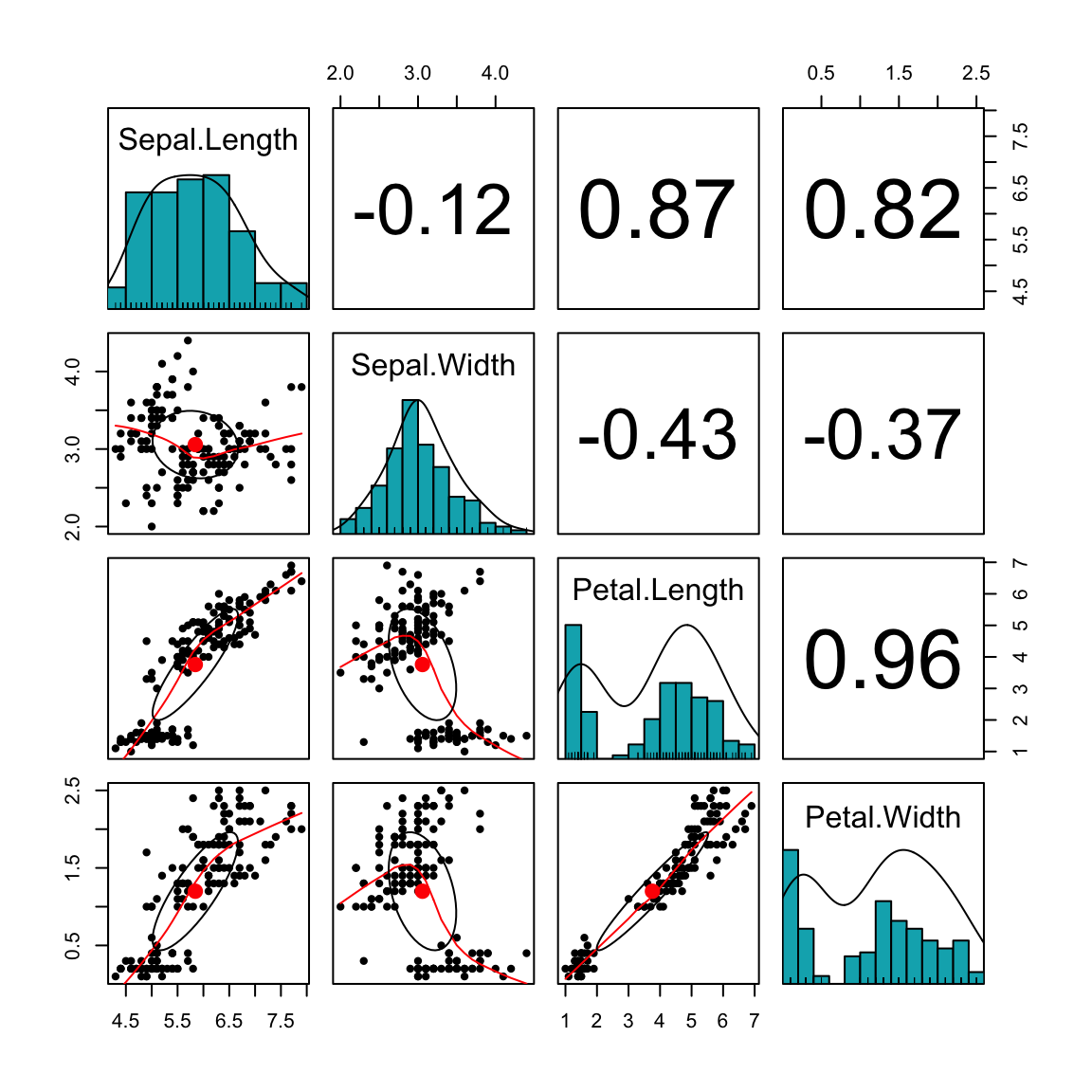
If lm = TRUE, linear regression fits are shown for both y by x and x by y. Correlation ellipses are also shown. Points may be given different colors depending upon some grouping variable.
See also
Infos
This analysis has been performed using R statistical software (ver. 3.2.4).
```
Show me some love with the like buttons below... Thank you and please don't forget to share and comment below!!
Montrez-moi un peu d'amour avec les like ci-dessous ... Merci et n'oubliez pas, s'il vous plaît, de partager et de commenter ci-dessous!
Recommended for You!
Recommended for you
This section contains the best data science and self-development resources to help you on your path.
Books - Data Science
Our Books
- Practical Guide to Cluster Analysis in R by A. Kassambara (Datanovia)
- Practical Guide To Principal Component Methods in R by A. Kassambara (Datanovia)
- Machine Learning Essentials: Practical Guide in R by A. Kassambara (Datanovia)
- R Graphics Essentials for Great Data Visualization by A. Kassambara (Datanovia)
- GGPlot2 Essentials for Great Data Visualization in R by A. Kassambara (Datanovia)
- Network Analysis and Visualization in R by A. Kassambara (Datanovia)
- Practical Statistics in R for Comparing Groups: Numerical Variables by A. Kassambara (Datanovia)
- Inter-Rater Reliability Essentials: Practical Guide in R by A. Kassambara (Datanovia)
Others
- R for Data Science: Import, Tidy, Transform, Visualize, and Model Data by Hadley Wickham & Garrett Grolemund
- Hands-On Machine Learning with Scikit-Learn, Keras, and TensorFlow: Concepts, Tools, and Techniques to Build Intelligent Systems by Aurelien Géron
- Practical Statistics for Data Scientists: 50 Essential Concepts by Peter Bruce & Andrew Bruce
- Hands-On Programming with R: Write Your Own Functions And Simulations by Garrett Grolemund & Hadley Wickham
- An Introduction to Statistical Learning: with Applications in R by Gareth James et al.
- Deep Learning with R by François Chollet & J.J. Allaire
- Deep Learning with Python by François Chollet
Click to follow us on Facebook :
Comment this article by clicking on "Discussion" button (top-right position of this page)







